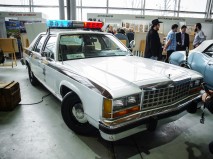1987 Ford LTD Crown Victoria Police
In 1980, the Crown Victoria name was revived by Ford (from the original 1955-56 top-of-the-range Fairlane coupe) for the upper-level trim package on the Ford LTD, replacing the LTD Landau. These cars had a targa-like chrome band across the roof, usually paired with a landau vinyl roof. While the chrome band was unique to the LTD Crown Victoria, the vinyl roof was a common option on its Lincoln-Mercury counterparts, the Mercury Grand Marquis and Lincoln Town Car. The car was available in coupe, sedan, and station wagon body styles through 1987.
In order to boost mid-size car sales, the LTD nameplate was moved to the mid-sized Ford Fox platform in 1983 to replace the Granada and Fairmont. The LTD Crown Victoriaremained on the full-sized Ford Panther platform, becoming a standalone model line. The old LTD 'S' front fascia was dropped, leaving only the former high-end quad-headlight fascia. Under the hood, the 122 hp 4.2L V8 from 1981-1982 was discontinued. Electronic "Central Fuel Injection" (CFI), a type of Throttle Body Injection, was now standard on the 5.0L V8 engine. While the Crown Victoria earned a reputation for its impressive durability, the CFI engine's induction system was a source of problems for drivers who experienced chronic stalling when in traffic.
1985 saw the horn control return to the steering wheel hub from its original location on the end of the turn signal lever. This was a major complaint among drivers of Ford products in the early 1980s, who often found themselves pounding on the steering wheel hub in vain. In 1986, on all civilian models, this was replaced by "Sequential Fire" electronic fuel injection, based on Ford's OBD-1 compliant EEC-IV computer. The new engine featured better driveability in traffic than the CFI unit, although it also had stalling problems which were caused by dirt in the air intake. Ford finally cured this problem with an inexpensive spacer that was installed in the air flow duct which bypassed the dirt.



